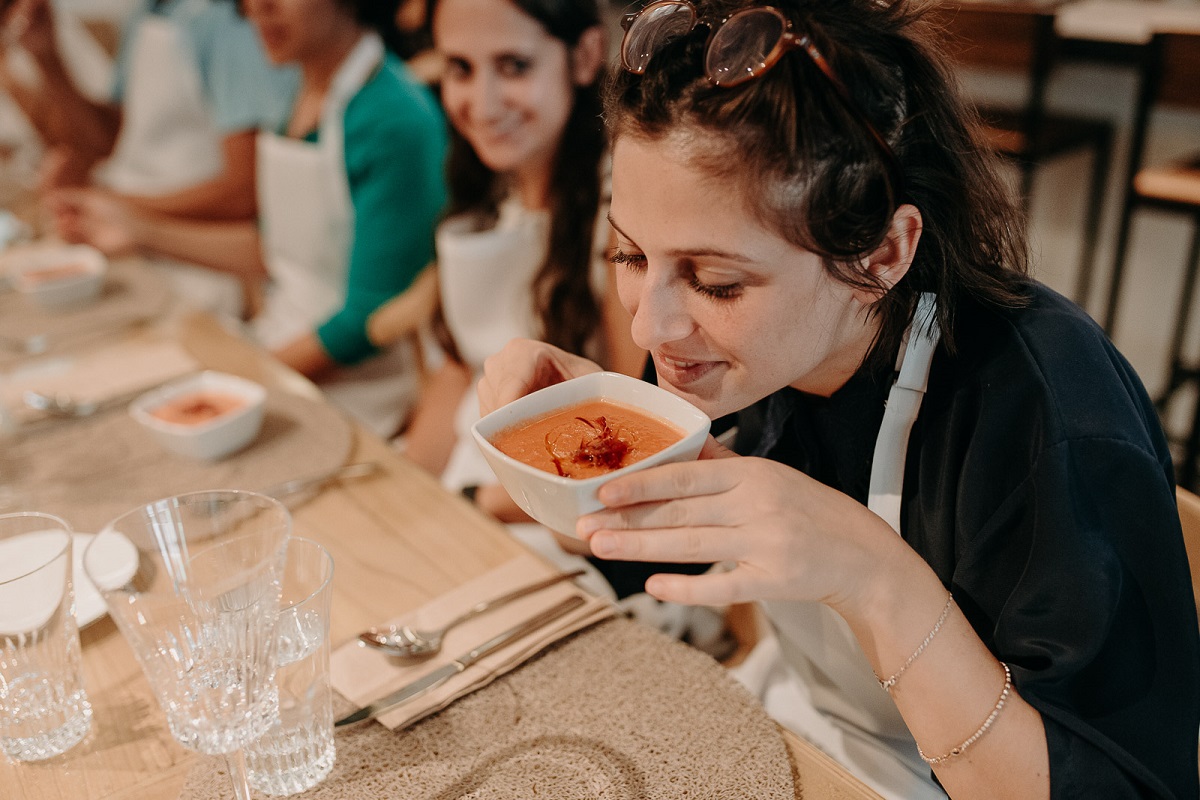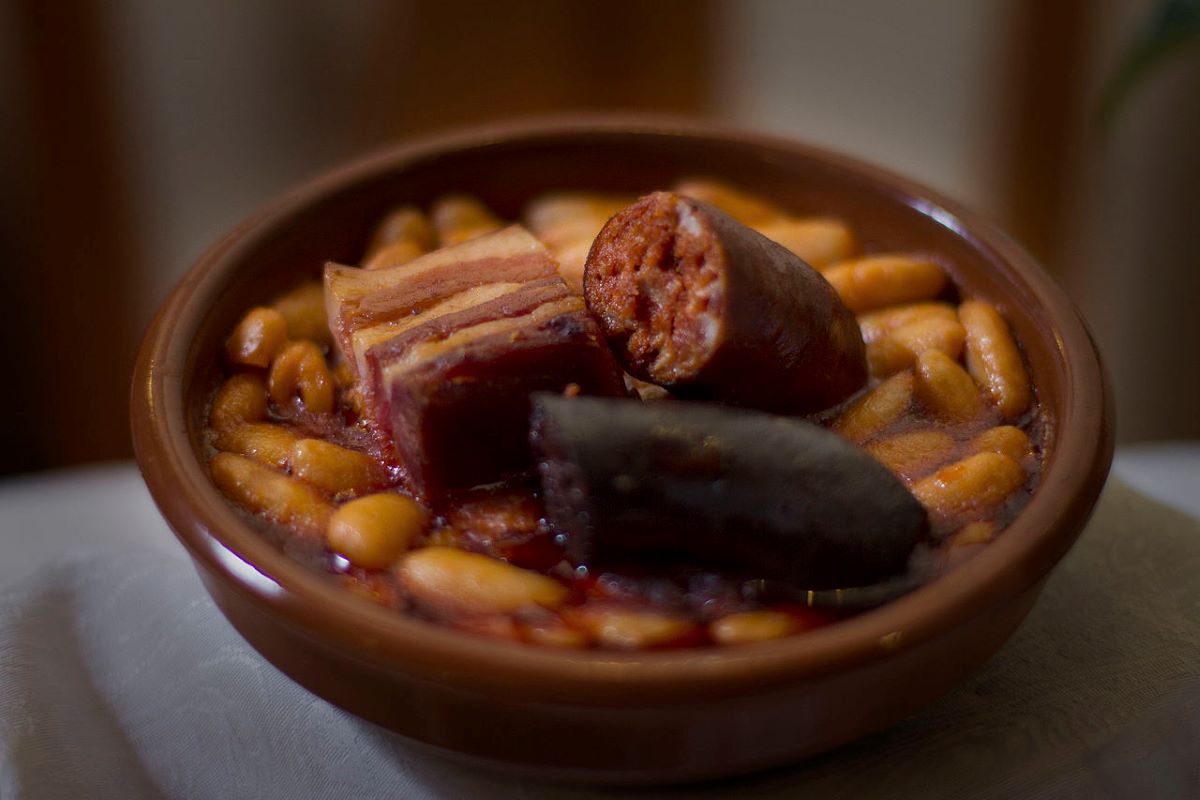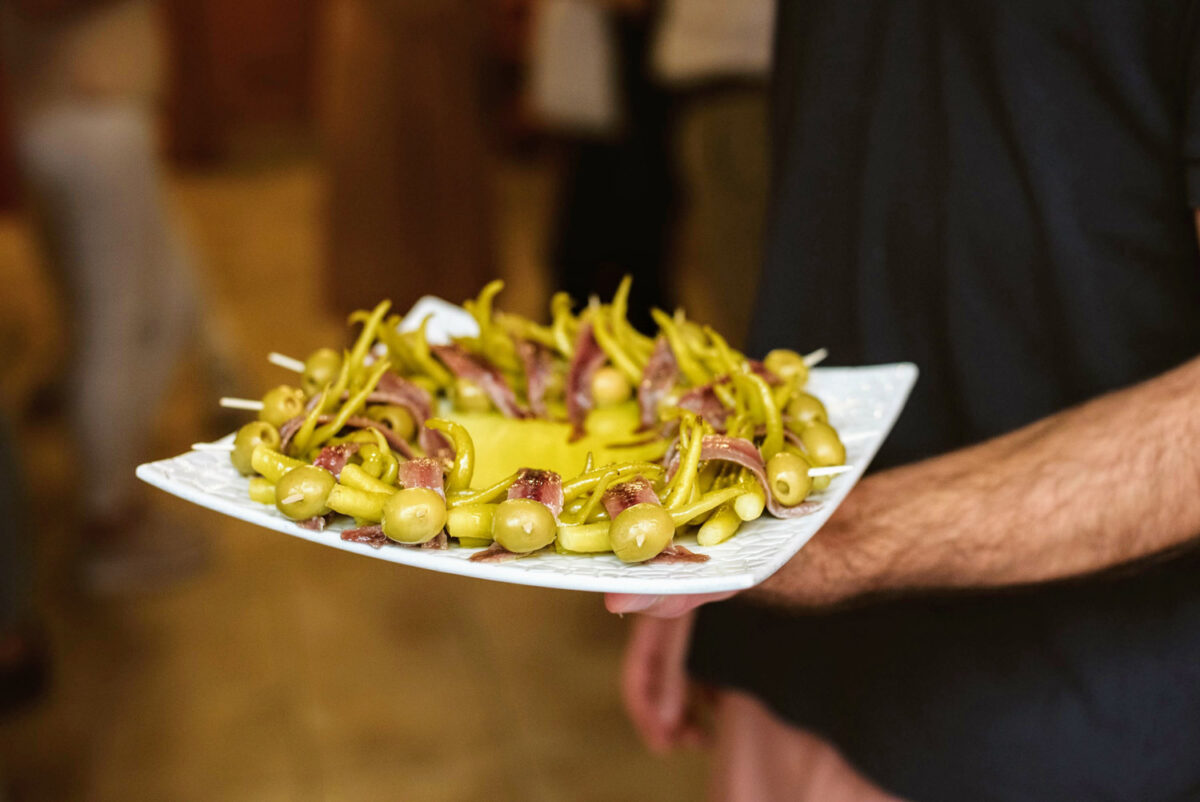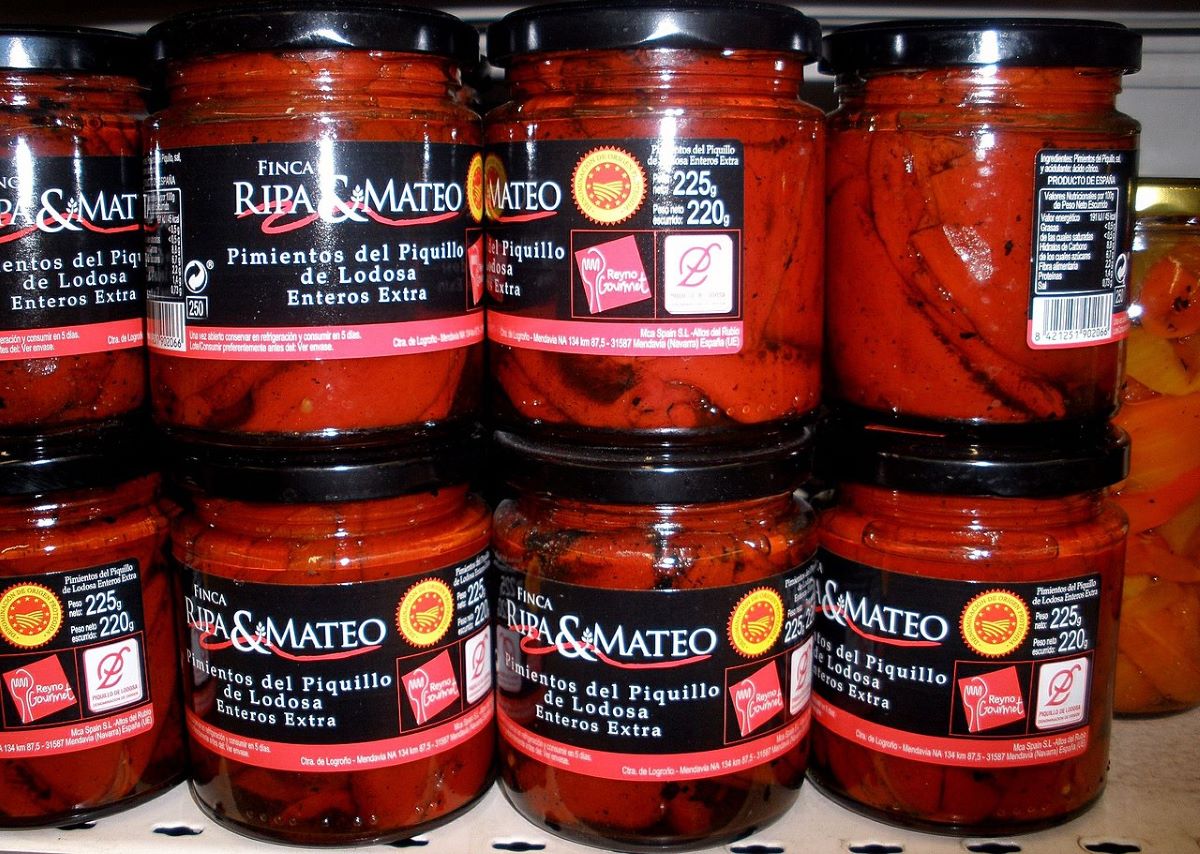Last Updated on November 12, 2025 by Emma Fajcz | Published: August 22, 2024
You’ve fallen in love with the rich, smoky flavors of Spanish chorizos, bean stews, and callos. The scarlet secret–Spanish paprika or Pimentón de la Vera–is now a must-have in your spice cabinet. As you browse the market, you’re faced with a variety of charming tin cans of this essential ingredient.
Which one do you choose? That’s where the Denomination of Origin in Spain, also known as Denominación de Origen (DO) in Spanish, certification comes in.
Introduced over 90 years ago, the DO seal is a stamp of approval you find on quality Spanish products. It means you get the best from original producers who have perfected their craft, whether it’s cultivating a spice, producing fine wine, or preserving artichokes.
If you’re looking for quality products in Spain, be sure to check for the Denomination of Origin seal.
What is the Denomination of Origin (DO) in Spain?
Before we take another bite out of this topic, let’s clarify that the Denominación de Origen (DO) or Denomination of Origin and the Denominación de Origen Protegida (DOP) or Protected Denomination of Origin are essentially the same.
The legal term evolved to add the “P” for “protected” after 2009, but the standards and significance of the seal remain unchanged.
Here’s what makes a food or drink worthy of this prestigious red label, according to the Spanish Association of Denominations of Origins:
- Geographical origin: The product originates from a specific geographical area.
- Unique quality and characteristics: The product must exhibit qualities and characteristics that are specifically tied to the region, including its geography, climate, and local production techniques.
- Production and processing: To earn that DOP label, the food or drink must be produced and processed entirely within that designated area.
Spain’s DOP seal assures you that your every bite or sip is rooted in tradition and is deeply connected to its place of origin. It’s a promise of quality, upheld by strict regulations and controls.
Can you spot Spain’s Denomination of Origin seal on this bottle of wine?
The difference between DOP, IGP, and DOQ
When the label isn’t red but blue, should you worry?
- The blue label signifies Indicación Geográfica Protegida (IGP), another mark of quality.
- The key distinction between DOP and IGP lies in where the production process occurs.
For a product to receive the DOP seal, the entire production process must occur within the designated geographical area. In contrast, an IGP product only requires that at least one stage of the process takes place within the designated area. As a result, the DOP seal indicates a stronger connection between the product and its specific geographical origin.
There’s one more label you may have encountered stamped on your favorite wine bottles: Denominación de Origen Qualificada or Calificada (DOQ or DOCA)
- This designation specifically applies to wines that have been granted the DO status but have consistently met and fulfilled stringent quality standards over an extended period.
There are only two regions that have been awarded a DOQ status:
- La Rioja and Priorat, an area located between Campo de Tarragona and the Ebro region.
Now that we’ve decoded our acronyms, let’s spice things up by exploring the rich gastronomic culture and delicacies celebrated by the DOP seals.
Some of these wines have DOP seals and others don’t, they’re easy to spot once you know what to look for.
How the Spanish DO food system reflects their gastronomic culture
Step into the kitchen of any Spanish home, and you’ll soon find that the crux of their dishes lies in using top-of-the-line ingredients:
- Whether they’re grandmothers preserving age-old recipes or Michelin-starred maestros, they know where to find the best of what’s on their grocery list.
- Morcilla? Dad only buys the ones from Burgos.
- Gamba blanca? Mom orders them online from Huelva.
It’s common knowledge to know where ingredients are supposed to be sourced from. Mention a new supplier, for example, and you’ll be met with a doubtful glance. Speak of a new recipe that veers away from the classic and a passionate debate will ensue.
The Spanish know how to cook, what to cook, and where to source the best ingredients. ¡Y punto!
It’s no surprise then that those that have proven their gastronomic value take immense pride in their food products. They can hold their head up high knowing their reputation is intact, their market is secure, and their prized product is protected by the Denominacion de Origen seal.

Well-Known DO regions and their distinct flavors
Where are these food-obsessed territories, you ask? They’re scattered across the country, each shaped by its unique terrain, which dictates its culinary destiny.
Here are a few of the special regions and their products that have earned the DOP stamp of quality.
Each region in Spain has it’s own specialty that’s awarded the Denomination of Origin seal.
Andalusia: Olive oil and sherry wine
Andalusia, under the warm Mediterranean sun, is all about olives and wine. The region’s olive groves produce some of the best olive oils, ranging from herbal to fruity and delicate to complex.
Sip sherry wine from the Jerez region for a taste of sunshine and to brighten up dessert time, especially if you’re having cheesecake.
Here are a few more of their DOP products:
- Olive Oils: Sierra de Cádiz, Córdoba (Baena, Adamuz, Priego de Córdoba, Lucena). Granada (Poniente de Granada, Montes de Granada); Jaén (Sierra de Cazorla, Sierra Mágina, Sierra de Segura), Málaga (Antequera), Sevilla (Estepa)
- Jerez Wine
- Vinegars
- Jamón: Córdoba (Los Pedroches), Huelva (Jabugo), Granada (Jamón de Trevélez)
- Aloreña Olives
- Cherimoya or Custard Apple
- Raisins
- Honey
Sherry is the oldest wine in Spain, and one of the oldest in Europe.
Castilla La Mancha: Saffron and manchego cheese
In the plains of Castilla-La Mancha, the setting for Don Quijote’s misadventures, Spanish saffron blooms like “red gold”. We have their vast fields and the grazing manchega sheep to thank for the intense and zesty manchego cheese and these DOP delicacies:
- Olive Oils: Campo de Calatrava, La Alcarria, Montes de Toledo
- Various wines
- Azafran or Saffron
- Manchego Cheese
- Arroz de Calasparra
Manchego cheese is buttery, firm, and zesty.
Galicia: Albariño wine and tetilla cheese
In the northwest corner of Spain lies the province of Galicia, where they take pride in their beautiful coast, rich heritage, and–of course–their mother’s home cooking. This is where the famous albariño wine originates, as well as the creamy, buttery tetilla cheese.
- Wines from Rías Baixas, Ribeira Sacra, Ribeiro, Monterrei, and Valdeorras
- Cheeses: Tetilla, Arzúa-Ulloa, Cebreiro
- Mussels
- Pimiento de Herbón
Travel tip:
- If you love exploring off the beaten path, Galicia should be on your list.
- At its center lies the city of Ourense, home to Nova, one of the most affordable Michelin-starred restaurants.
- Before you feast, take a relaxing dip in the hot springs along the cold, rushing river.
- Less than an hour away, you can visit the historic terraces of Ribeira Sacra, known for their breathtaking views and steep vineyards, which are some of the most difficult to harvest.
Just remember the golden rule of pimientos de padrón: “some are hot and some are not!”
Asturias: Cider, blue cheese, and beans
Set against the stunning Picos de Europa mountain range, you can visit the caves of Cabrales to learn how they produce their pungent blue cheese. Journey towards the coast with thousands of beautiful sandy coves and indulge in their hearty Fabada bean stew, refreshing cider, and more Asturian DOP certified specialties.
- Wine of Cangas
- Cheeses: Cabrales, Afuega’l Pitu, Gamonedo, Queso Casín, Queso Los Beyos
- Faba Beans
- Apple Cider
- Spelt made from Wild Wheat
Travel tip:
- If you find yourself in this often-overlooked part of Spain and are up for a scenic drive through mountain towns, make sure to visit the caves of Cabrales.
- Walk through the centuries-old tradition of producing and storing blue cheese in cool, natural caves hidden in the mountains. Picture the epic hikes that lead to this perfect, cheesy delight.

Basque Country: Txakoli wine and Idiazabal cheese
In friendly competition with Asturias, the gastronomic stronghold that is the Basque Country showcases its own DOP cider and black beans from Tolosa. Despite the rugged mountains and strong Atlantic breeze that challenges grape cultivation, the region produces the unique txakoli wine that pairs perfectly with their rich, smoky Idiazabal cheese topped with fig jam.
- Wines: Txakoli, La Rioja (Alava Region)
- Idiazabal Cheese
- Tolosa Beans
- Apple Cider

Catalonia: Bubbly Cava and grainy pears
Catalonia’s coastal plains and mountain slopes produce Cava, Spain’s beloved sparkling wine. From the Penedès region, where vineyards soak up the Mediterranean sun, Cava represents Catalan craftsmanship and celebration. Pair it with sweet, juicy, and crunchy pears from Lleida, another DOP-certified product from the region.
- Arbequina Olive Oil of Siurana
- Wines: Cava, Priorat
- Cheeses and butter from Alt Urgell
- Legumes
- Pears of Lleida
- Hazelnuts of Reus

Must-Try Spanish products with the DO Seal
Ask a local, “What food and wine should I try?” They’ll eagerly share their favorites. Sampling local products—certified or not—is always a great idea when exploring Spain.
Whether it’s the calçots in Valls or the diverse anchovy pintxos in San Sebastian, there’s nothing like savoring a quality product right at its source.
With so many incredible options, this article could easily become a novel, but let’s focus on three special DOP categories so vast, they deserve a closer look.

Spanish olive oil varieties and regions
Spanish olive oil is renowned worldwide for its exceptional quality and variety. Here’s a beginner’s guide to olive oil, exploring the different types and their regions:
- Picual: Predominantly from Jaén in Andalusia, its robust flavor and high stability makes it perfect for cooking at high temperatures as well as preserving meats, cheeses, and the like.
- Hojiblanca: Also produced mainly in Andalusia, this olive oil is well-balanced but slightly fruity and herbal with a hint of bitter and spice.
- Arbequina: Originating from Catalonia and Aragón, it is bitter and spicy with a tinge of sweetness.
- Cornicabra: From Montes de Toledo en Castilla-La Mancha, this variety has a strong, peppery flavor.
Travel tip:
- Consider an olive oil tasting experience in Córdoba or Sevilla, where you can sample varieties and learn from professionals.
Picking the perfect bottle is easier than you think…as long as you know what to look for.
Jamon Ibérico and Serrano, and other specialty meats
Spain’s love affair with cured meats is legendary. It only takes a creamy slice of jamón ibérico de bellota to understand why. The price tag on this prized ham can reach over $4,000.
Aren’t you glad you can rely on the DO certification to ensure you’re investing in quality?
Here are some renowned Spanish specialty meats and the DOP and IGP regions they come from:
- Jamón Ibérico: Extremadura (DOP), Salamanca (DOP), Huelva (DOP), and Córdoba (DOP)
- Jamón Serrano: Teruel (DOP), Almería (IGP), and Granada (IGP)
- Morcilla (Blood Sausage): Burgos (IGP)
- Chorizo: La Rioja (IGP) and Cantimpalos (IGP)
Jamón is world-renowned for a reason.
The wide world of Spanish wine according to the Denomination of Origin in Spain
Did you know that the DOP system began with Spanish wine? As Spain’s viticulture gained fame, there needed to be a way to ensure quality and protect the long-standing wine producers who have refined their tastes and techniques through the ages.
Here are some of the most famous Spanish wines and their regions:
- Rioja: The first region to earn a DOP, it is known for its tempranillo-based red wines.
- Ribera del Duero: Located in Castilla y León, it’s famous for robust red wines also made from tempranillo.
- Priorat: From Catalonia, known for powerful red wines made from grenache and carignan grapes.
- Rías Baixas: Located in Galicia, renowned for its crisp, aromatic albariño white wines.
- Alava, Bizkaia, Getaria: Geographical areas in the Basque Country that produce the spritzy txakoli white wine.
- Penedès: Famous for Cava, a sparkling wine similar to Champagne.
Travel tip:
- If you’re curious to learn more about Spanish wine, take a tour through one of over 500 bodegas in La Rioja for their interesting winemaking history and traditions.
Spanish wine is where the Denomination of Origin in Spain’s seal originated.
How the Denomination of Origin (DO) in Spain safeguards Spanish heritage and tradition
Spain is a global pioneer in certifying regional food products, driven by its deep-rooted love for food and gastronomy. The Denominación de Origen Protegida (DOP) and Indicación Geográfica Protegida (IGP) seals serve three purposes:
- To protect, promote, and elevate the value of agrifood products.
- To guard against imitations.
- And to provide consumers with accurate information about the food products they enjoy.
This initiative sparked an exploration into the unique qualities of regional produce, uncovering their secrets and meticulously documenting every step of their production processes. These efforts ensure that the exceptional quality and rich traditions of Spanish foods are preserved and celebrated for generations to come.
Consider the jamón ibérico Jabugo from Huelva, for example:
- This special breed of Iberian pig has a higher unsaturated fat content.
- The region’s unique, dry climate–with its Atlantic winds–influences their diet of herbs, flowers, grass, and especially acorns, which then results in healthier fat rich in oleic acid, fiber, vitamins, and minerals.
- The same pigs raised elsewhere simply wouldn’t achieve the same characteristics, taste, or texture.
Another example are the Spanish piquillo peppers from Lodosa:
- Amidst growing competition from countries like China and Peru, this small town in Navarra upholds quality by sticking to its strict DOP-approved process, going as far as peeling the smoked peppers by hand.
Even in an age of massive globalization and mass production, this initiative has breathed new life into regional and local economies in Spain. It ensures that traditional food processes are not just preserved but also celebrated and cherished.

From seal to soul: The DOP legacy
As you stand in the grocery store, eyeing the array of colorful tin cans of Spanish paprika, you’re now equipped with the knowledge to choose with confidence. Look for “Pimentón de la Vera” with the DOP seal to ensure you’re buying the genuine article.
La Vera, located in the hot, dry province of Cáceres, conjures images of ancient Roman bridges, serene rivers, and sprawling fields of vibrant red peppers. Now we know that this picturesque landscape isn’t just a backdrop; it’s integral to the distinctive quality of the paprika produced here.
Now we understand that the DOP seal represents more than just a guarantee of quality; it’s a tribute to Spain’s rich culinary tradition. It’s a celebration of the country’s cherished food products, transforming each bite into a window into Spain’s food-loving heart and soul.
Use your new knowledge to spot Spain’s Denomination of Origin stickers and select the best quality products.








